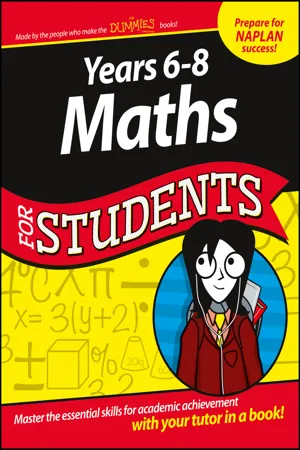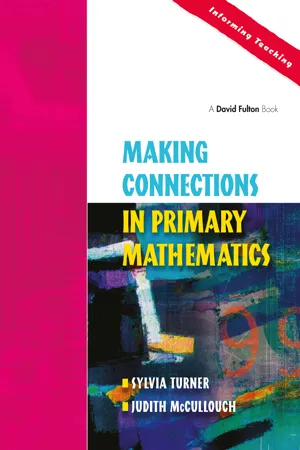Mathematics
2-Dimensional Figures
2-dimensional figures are shapes that exist in two dimensions, typically on a flat surface. They have length and width, but no depth. Common examples include squares, rectangles, circles, triangles, and polygons. These figures are fundamental to geometry and are used to study properties such as area, perimeter, and angles.
Written by Perlego with AI-assistance
Related key terms
3 Key excerpts on "2-Dimensional Figures"
- eBook - ePub
- (Author)
- 0(Publication Date)
- For Dummies(Publisher)
orientation — if you twist a square around, the shape is still a square, even if it looks like a diamond. Regardless of how big a shape is or which way around you draw it, a shape’s properties and name stay the same.You also need to know the difference between two-dimensional and three-dimensional shapes. The ‘D’ in a 3D movie stands for ‘dimensions’. The dimensions make the movie seem as if everything isn’t just flat on a screen but has depth. Similarly, in maths, two-dimensional objects are flat (you can draw them on paper) and three-dimensional figures come out of the page.Sussing out shapes you know
You need to recognise the following two-dimensional — or flat — shapes, which I also show in Figure 11.1 :- Square: A shape with four equal-length straight sides arranged at right-angles to each other.
- Rectangle: A shape with four straight sides at right-angles to each other. The sides aren’t necessarily all the same length, but sides opposite each other are always the same length.
- Triangle: A shape with three straight sides. As you progress with maths, most of the geometry you do is based on triangles.
- Circle: This is the only curved shape you really need to know about. The technical definition is ‘a shape with all of the points a fixed distance from the centre’, but you’ll recognise a circle when you see one.
Figure 11-1 : A square, a rectangle, a triangle and a circle.Three-dimensional figures are objects that don’t lie flat. The following four three-dimensional figures, which I show in Figure 11.2 , are closely linked to the four major two-dimensional shapes that I describe in the preceding list:- Cube: The shape of a normal die. Each of a cube’s sides is a square, and all of the edges are the same length.
- Cuboid:
- eBook - ePub
- Sylvia Turner, Judith McCulloch(Authors)
- 2017(Publication Date)
- Routledge(Publisher)
Subject knowledge to teach properties of shape can be divided into three broad areas: 2D shapes, 3D shapes and constructions including nets of shapes. You may find that you have forgotten much of the terminology associated with shape. The specific language used enables shapes to be classified into categories and the process of classification helps us make sense of our experiences. The skills practised through classifying shapes can help children to classify numbers according to their properties. Teachers have to make this connection for children.2D shapes
We can classify 2D shapes according to whether their sides are straight or curved. Those with curved sides are generally familiar to children - a circle (e.g. the face of a clock) and a semicircle are the main plane shapes with curved sides that children will consider at primary level. An oval or ellipse is a familiar shape to children from their writing of the letter ‘o’ and the symbol for zero, but its mathematical properties are not considered at this stage.A 2D straight-sided closed shape is called a polygon . Polygons can be classified according to:• the number of sides of the polygon - triangles three sides, quadrilaterals four sides, pentagons five sides etc.;• regularity - polygons can be regular or irregular. They are regular when all the sides are the same length and all the angles the same size.Further classification is possible of triangles and quadrilaterals. Triangles can be classified according to their sides - equilateral (all sides equal length), isosceles (two sides equal length), scalene (no equal sides). Also, we consider their angles - acute (less than 90 degrees), obtuse (more than 90 degrees), right-angled (90 degrees), reflex (more than 180 degrees).Similarly, quadrilaterals can be classified into those that have parallel sides and those that do not. The majority of the quadrilaterals we use have at least one pair of parallel sides. A further refinement of definition could separate out those quadrilaterals into those with no parallel sides, those with one pair of parallel sides and those with two pairs of parallel sides, known as parallelograms. These parallelograms can then be further subdivided through the additional definition of whether or not they have internal right angles and/or whether or not any of their sides are of equal length. - eBook - ePub
The Learning and Teaching of Geometry in Secondary Schools
A Modeling Perspective
- Pat Herbst, Taro Fujita, Stefan Halverscheid, Michael Weiss(Authors)
- 2017(Publication Date)
- Routledge(Publisher)
p.48 2 GEOMETRIC FIGURES AND THEIR REPRESENTATIONS 2.1. IntroductionThe notion of geometric figure, while defined loosely as well as restrictedly by Euclid (“14. A figure is that which is contained by any boundary or boundaries”, Euclid, 1956, p. 153), is central to Euclid’s Elements : Postulates enable possible figure constructions, and propositions assert properties of those figures or demonstrate that other figures can be constructed. Later expositions of geometric knowledge have varied in the extent to which they center on the notion of figure, with modern treatises either making figure a centerpiece as an application of set theory (“by figure we mean a set of points”, Moise, 1974, p. 37) or making figure a derived notion within a more general consideration of geometry as the study of transformations of space onto itself (see for example Guggenheimer, 1967; see also Jones, 2002; Usiskin, 1974).The notion of figure has also played a crucial role in scholarship on the teaching and learning of geometry (e.g., Duval, 1995; Fischbein, 1993). This chapter considers how scholarship from various disciplines has influenced our community’s thinking about geometric figures. It brings perspectives from mathematics and mathematicians, from the history and philosophy of mathematics, from cognitive science and semiotics, from technology and from mathematics education proper. Influenced by those perspectives we elaborate on the role of the geometric figure in geometry teaching and learning.We articulate some conceptions of figure related to its various representations in the context of making a curricular proposal on which to found research and development: To conceptualize the study of geometry in secondary schools as a process of coming to know figures as mathematical models of the experiential world. By this we mean that the study of geometry in secondary school could be seen as the development and use of conceptions of figure for students to make a particular kind of sense of their experiences with space and shape in the world: A sense-making akin to that of an applied mathematician creating a model of a real world phenomenon. This assertion clearly is not meant as a statement of fact—we have not ascertained that such a position is articulated by a majority of curricular offerings in geometry. Nor do we intend it prescriptively or ideologically, as a statement of how we think curriculum ought to be designed. Rather, the assertion is meant as the proposition of a perspective from which to read existing research: If the study of geometry were to be conceived of in that way, what would the existing research have to say about it? The assertion is also intended as the proposal of a large design research project within which to ask further research questions: If the study of geometry could be conceived of in that way, what could it look like, what could it make possible as far as students’ thinking and learning, what knowledge might it require of teachers, and what demands and tensions might it pose for teachers?
Learn about this page
Index pages curate the most relevant extracts from our library of academic textbooks. They’ve been created using an in-house natural language model (NLM), each adding context and meaning to key research topics.


